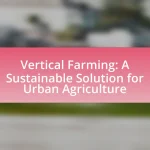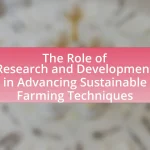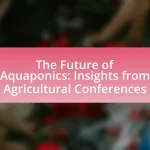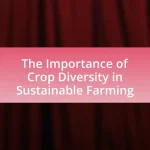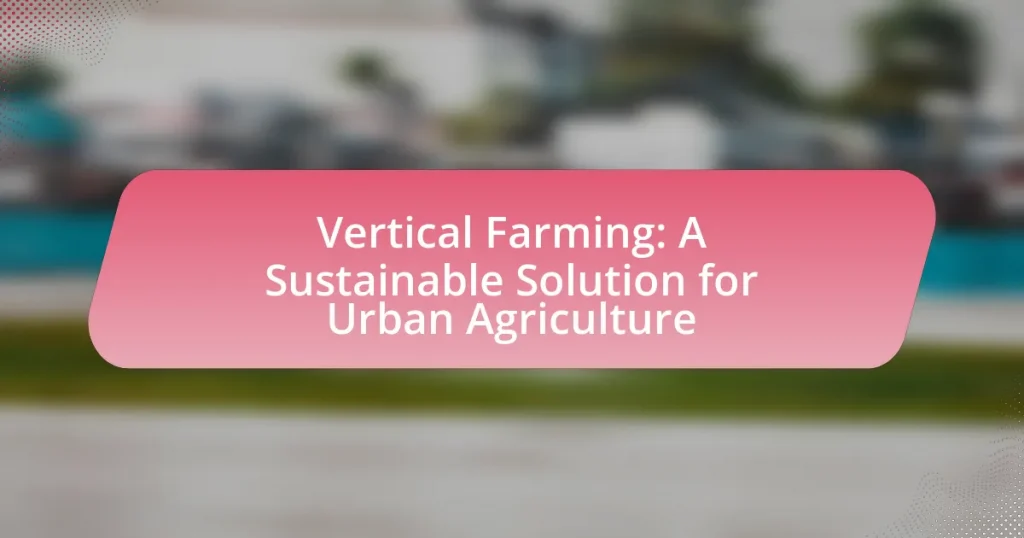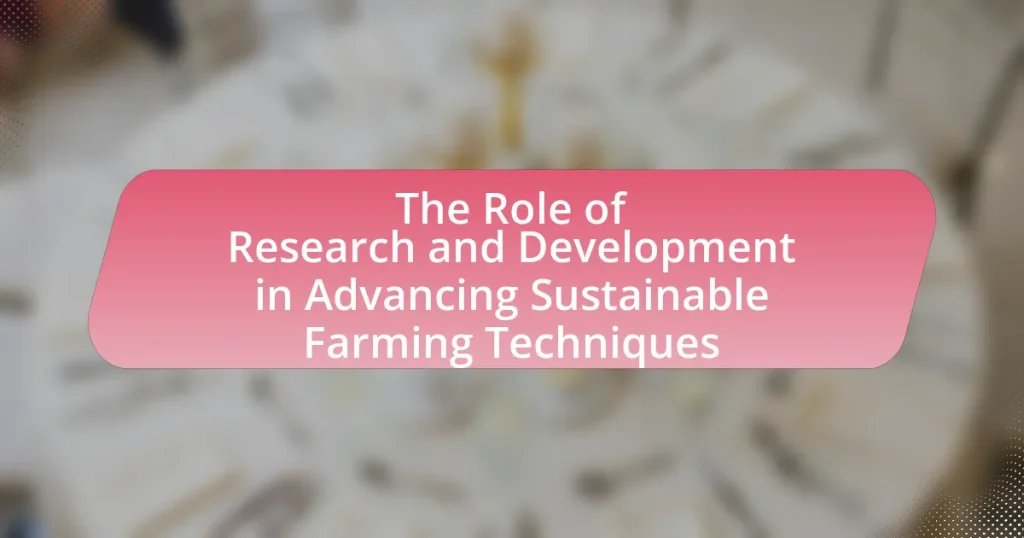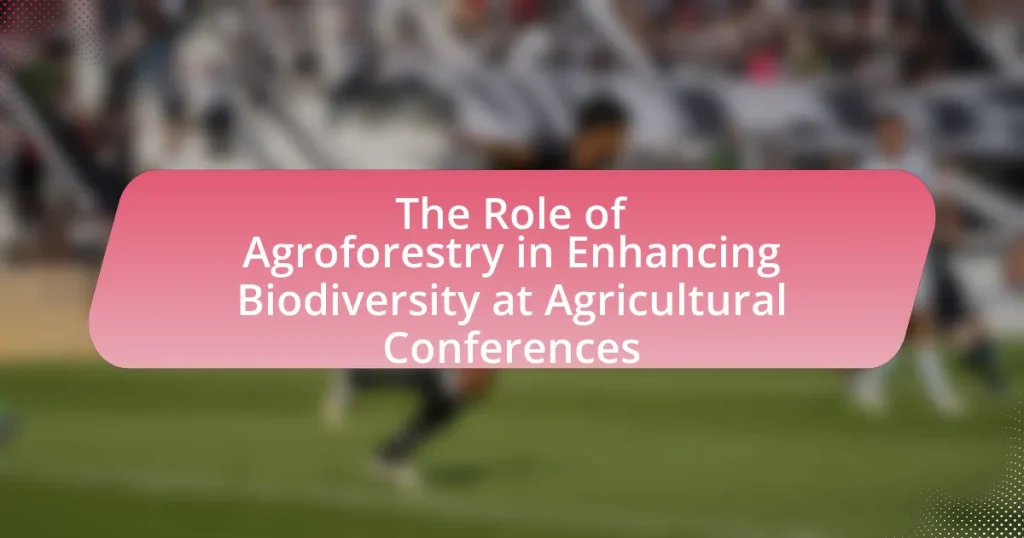Vertical farming is an innovative agricultural method that involves growing crops in vertically stacked layers, utilizing controlled-environment agriculture technology to maximize space and resource efficiency. This approach significantly reduces water usage by up to 90% compared to traditional farming, making it a sustainable solution for food production in urban areas. The article explores the differences between vertical farming and conventional agriculture, the technologies employed, environmental benefits, and its role in enhancing food security. Additionally, it addresses the challenges and economic implications of vertical farming, including investment opportunities and best practices for ensuring crop quality and yield.
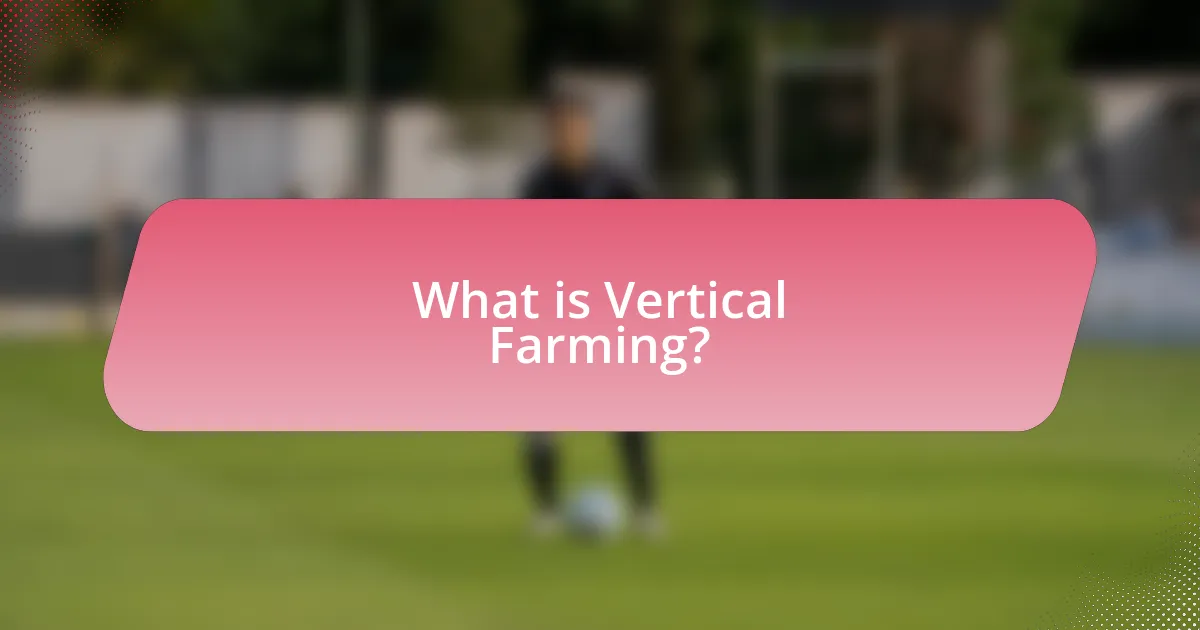
What is Vertical Farming?
Vertical farming is an innovative agricultural practice that involves growing crops in vertically stacked layers or structures, often utilizing controlled-environment agriculture technology. This method maximizes space efficiency and resource use, allowing for food production in urban areas where land is limited. According to a report by the Food and Agriculture Organization, vertical farming can reduce water usage by up to 90% compared to traditional farming methods, making it a sustainable solution for addressing food security in densely populated regions.
How does Vertical Farming differ from traditional agriculture?
Vertical farming differs from traditional agriculture primarily in its use of vertical space and controlled environments to grow crops. While traditional agriculture relies on horizontal land and natural conditions, vertical farming utilizes stacked layers and often incorporates hydroponics or aeroponics, allowing for higher crop yields in smaller areas. For instance, vertical farms can produce up to 10 times more food per square foot compared to conventional farming methods, as reported by the Food and Agriculture Organization. Additionally, vertical farming minimizes water usage by up to 90% through recirculation systems, contrasting with traditional agriculture, which often faces water scarcity issues.
What technologies are utilized in Vertical Farming?
Vertical farming utilizes technologies such as hydroponics, aeroponics, and aquaponics to grow crops without soil. Hydroponics involves growing plants in nutrient-rich water, while aeroponics uses mist to deliver nutrients directly to plant roots. Aquaponics combines hydroponics with aquaculture, allowing fish waste to provide nutrients for plants. Additionally, vertical farms often employ LED lighting systems to optimize plant growth and climate control systems to maintain ideal growing conditions. These technologies enhance resource efficiency, reduce land use, and enable year-round crop production, making vertical farming a viable solution for urban agriculture.
How does the growing environment in Vertical Farming work?
The growing environment in vertical farming utilizes controlled conditions to optimize plant growth. This environment typically includes artificial lighting, climate control systems, and hydroponic or aeroponic systems to provide nutrients and water directly to the plants’ roots. For instance, LED lights are often used to simulate sunlight, allowing for year-round cultivation regardless of external weather conditions. Additionally, vertical farms can regulate temperature, humidity, and CO2 levels, which enhances plant growth rates and yields. Research indicates that vertical farming can produce up to 10 times more food per square foot compared to traditional farming methods, demonstrating its efficiency and sustainability in urban agriculture.
Why is Vertical Farming considered a sustainable solution?
Vertical farming is considered a sustainable solution because it significantly reduces land use and resource consumption while maximizing crop yield. This method utilizes controlled environments to grow food in vertically stacked layers, which can be implemented in urban settings, thus minimizing transportation emissions. Additionally, vertical farms often employ hydroponics or aeroponics, which use up to 90% less water than traditional farming methods. Research indicates that vertical farming can produce up to 10 times more food per square foot compared to conventional agriculture, making it a highly efficient and eco-friendly approach to food production.
What are the environmental benefits of Vertical Farming?
Vertical farming offers significant environmental benefits, including reduced land use, lower water consumption, and decreased carbon emissions. By utilizing vertical space, these farms can produce food in urban areas, minimizing the need for extensive agricultural land, which is often a source of deforestation and habitat loss. Research indicates that vertical farms can use up to 90% less water than traditional farming methods due to recirculating systems that optimize water usage. Additionally, vertical farming reduces transportation emissions since food can be grown closer to urban consumers, cutting down on the carbon footprint associated with long-distance food transport. These factors collectively contribute to a more sustainable agricultural model that addresses environmental challenges.
How does Vertical Farming contribute to food security?
Vertical farming contributes to food security by enabling the production of crops in urban areas, reducing reliance on traditional agriculture. This method utilizes controlled environments to grow food year-round, independent of weather conditions, which increases crop yield and consistency. For instance, vertical farms can produce up to 10 times more food per square foot compared to conventional farming, as demonstrated by studies showing that indoor farms can yield 2 to 10 times more produce annually. Additionally, vertical farming minimizes transportation costs and emissions by situating food production closer to consumers, thus enhancing access to fresh produce in urban settings.
What challenges does Vertical Farming face?
Vertical farming faces several significant challenges, including high initial capital costs, energy consumption, and technological complexity. The establishment of vertical farms requires substantial investment in infrastructure, which can deter potential investors. For instance, a study by the National Renewable Energy Laboratory indicates that the capital costs for vertical farming can range from $100 to $200 per square foot, making it a costly endeavor. Additionally, vertical farms often rely on artificial lighting and climate control systems, leading to high energy consumption; research shows that energy costs can account for up to 50% of operational expenses. Furthermore, the technological complexity of managing hydroponic or aeroponic systems can pose operational challenges, requiring specialized knowledge and skills that may not be readily available in the workforce.
What are the economic challenges associated with Vertical Farming?
The economic challenges associated with vertical farming include high initial capital investment, operational costs, and market competition. High initial capital investment is required for advanced technology, infrastructure, and equipment, which can exceed millions of dollars. Operational costs, including energy, labor, and maintenance, are also significant; for instance, energy costs can account for up to 30% of total operational expenses. Additionally, market competition from traditional agriculture and other food production methods can pressure pricing and profitability, making it difficult for vertical farms to achieve sustainable financial viability.
How do regulatory issues impact Vertical Farming?
Regulatory issues significantly impact vertical farming by influencing operational costs, compliance requirements, and market access. Regulations regarding zoning, building codes, and agricultural practices can create barriers to entry for new vertical farms, often requiring extensive permits and adherence to specific standards. For instance, in the United States, the Food and Drug Administration (FDA) has guidelines that affect how produce is grown and sold, which can complicate the operations of vertical farms. Additionally, local regulations may dictate the types of crops that can be cultivated or the technologies that can be employed, thereby shaping the business models of vertical farming enterprises. These regulatory frameworks can either facilitate innovation and growth in the sector or hinder its development by imposing stringent compliance costs and operational limitations.
How can Vertical Farming be integrated into urban settings?
Vertical farming can be integrated into urban settings through the utilization of existing structures, such as rooftops and vacant buildings, to create multi-layered growing environments. This approach maximizes space efficiency and reduces the need for land, which is often scarce in cities. For instance, a study by the University of California, Davis, found that urban vertical farms can produce up to 10 times more food per square foot compared to traditional farming methods. Additionally, incorporating hydroponic and aeroponic systems allows for year-round crop production while minimizing water usage by up to 90%. Urban vertical farms can also contribute to local economies by providing fresh produce to nearby communities, reducing transportation emissions and enhancing food security.
What role does community play in the success of Vertical Farming?
Community plays a crucial role in the success of vertical farming by fostering collaboration, supporting local economies, and enhancing consumer engagement. Collaborative efforts among community members can lead to shared resources, knowledge exchange, and innovative practices that improve operational efficiency in vertical farms. Additionally, when local communities invest in and support vertical farming initiatives, they contribute to economic sustainability by creating jobs and promoting local food production. Research indicates that community-supported agriculture (CSA) models, which often include vertical farming, can increase consumer awareness and demand for locally grown produce, thereby driving sales and ensuring the viability of these farming operations.
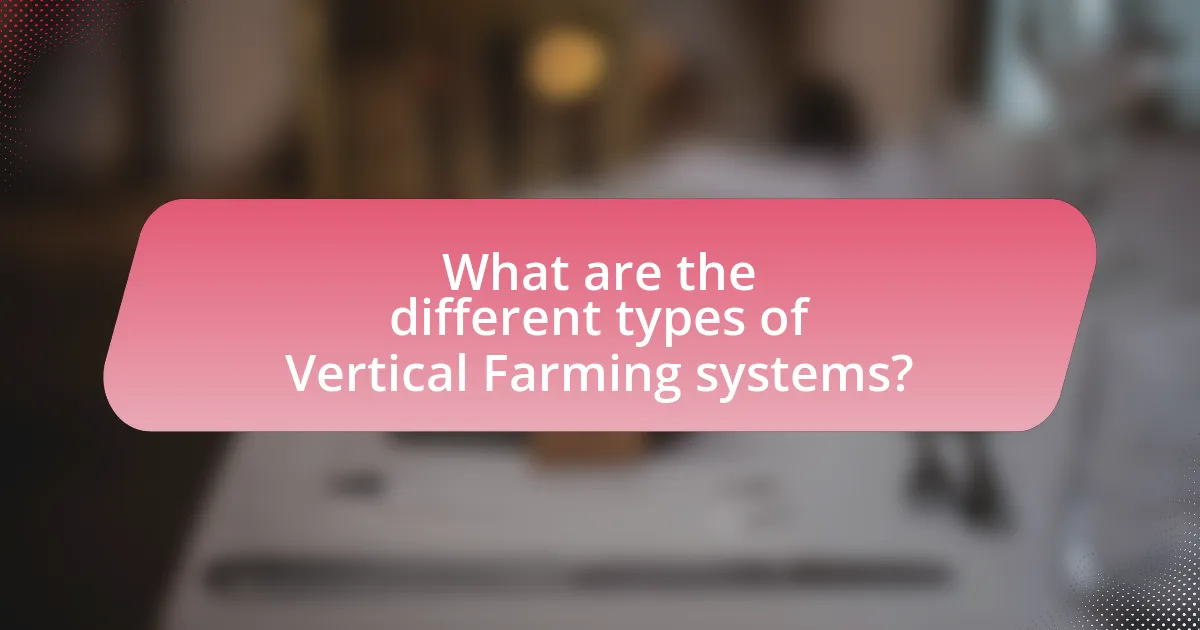
What are the different types of Vertical Farming systems?
The different types of vertical farming systems include hydroponics, aeroponics, aquaponics, and soil-based systems. Hydroponics utilizes nutrient-rich water solutions to grow plants without soil, allowing for efficient nutrient absorption and faster growth rates. Aeroponics involves suspending plants in air and misting their roots with nutrient solutions, which maximizes oxygen exposure and minimizes water usage. Aquaponics combines hydroponics with aquaculture, where fish waste provides nutrients for the plants, creating a symbiotic environment. Soil-based systems, while less common in vertical farming, use soil in stacked layers to grow crops. Each system has unique advantages and is chosen based on specific agricultural goals and environmental conditions.
How do hydroponic systems work in Vertical Farming?
Hydroponic systems in vertical farming operate by growing plants in a nutrient-rich water solution instead of soil. This method allows for efficient space utilization, as plants can be stacked vertically, maximizing yield per square foot. Hydroponics provides essential nutrients directly to the plant roots, promoting faster growth and higher productivity compared to traditional farming methods. Research indicates that hydroponic systems can use up to 90% less water than conventional agriculture, making them a sustainable choice for urban environments where water scarcity is a concern.
What are the advantages of hydroponic systems?
Hydroponic systems offer several advantages, including increased crop yield, efficient use of water, and reduced need for pesticides. These systems allow plants to grow faster than in traditional soil-based agriculture due to the direct delivery of nutrients to the roots, resulting in higher productivity. Additionally, hydroponics uses up to 90% less water compared to conventional farming methods, as water is recirculated and reused within the system. Furthermore, the controlled environment of hydroponic systems minimizes pest infestations, leading to a significant reduction in pesticide application, which is beneficial for both health and the environment.
What crops are best suited for hydroponic Vertical Farming?
Leafy greens such as lettuce, spinach, and kale are best suited for hydroponic vertical farming. These crops thrive in controlled environments and have short growth cycles, making them ideal for hydroponic systems. Research indicates that leafy greens can yield up to 10 times more produce per square foot compared to traditional farming methods, due to the efficient use of space and resources in vertical farming setups. Additionally, herbs like basil and mint also perform well in hydroponic systems, benefiting from the nutrient-rich water and optimized light conditions.
What is the role of aeroponics in Vertical Farming?
Aeroponics plays a crucial role in vertical farming by enabling the growth of plants in a soil-less environment through a mist or aerosolized nutrient solution. This method enhances plant growth rates and resource efficiency, as it uses up to 90% less water compared to traditional farming methods. Studies have shown that aeroponic systems can yield crops faster and with higher nutrient density, making them ideal for urban agriculture where space and resources are limited.
How does aeroponics compare to other farming methods?
Aeroponics is a highly efficient farming method that uses mist to deliver nutrients to plant roots, distinguishing it from traditional soil-based and hydroponic systems. Unlike soil farming, which relies on land and can be affected by pests and diseases, aeroponics minimizes these risks and requires significantly less water—up to 90% less than conventional agriculture. Compared to hydroponics, which uses a nutrient-rich water solution, aeroponics allows for faster plant growth and higher yields due to increased oxygen exposure to the roots. Studies have shown that aeroponic systems can produce crops in a fraction of the time, with some plants growing up to 30% faster than in hydroponic setups.
What are the benefits of using aeroponics in urban agriculture?
Aeroponics offers significant benefits in urban agriculture, including reduced water usage, increased crop yield, and space efficiency. This method uses up to 90% less water than traditional farming, as it recycles water and nutrients in a closed system. Additionally, aeroponics can produce crops up to 30% faster due to optimal nutrient delivery and oxygenation, which enhances plant growth. The vertical nature of aeroponic systems allows for cultivation in limited urban spaces, maximizing production per square foot. These advantages make aeroponics a viable and sustainable solution for urban food production.
What innovations are shaping the future of Vertical Farming?
Innovations shaping the future of vertical farming include advanced hydroponics, automation technologies, and artificial intelligence. Advanced hydroponics systems allow for efficient nutrient delivery and water usage, significantly reducing resource consumption. Automation technologies, such as robotics and IoT sensors, enhance operational efficiency by monitoring plant health and optimizing growth conditions. Artificial intelligence contributes by analyzing data to predict crop yields and manage resources effectively. These innovations collectively improve sustainability and productivity in urban agriculture, addressing food security challenges in densely populated areas.
How is automation transforming Vertical Farming practices?
Automation is transforming vertical farming practices by enhancing efficiency, precision, and scalability in crop production. Automated systems, such as robotic planting and harvesting, enable farmers to reduce labor costs and increase yield consistency. For instance, a study by the University of California found that automated vertical farms can achieve up to 30% higher productivity compared to traditional methods due to optimized resource management and reduced human error. Additionally, automation facilitates real-time monitoring of environmental conditions, allowing for precise adjustments in lighting, temperature, and nutrient delivery, which further improves plant growth and resource utilization.
What role does data analytics play in optimizing Vertical Farming?
Data analytics plays a crucial role in optimizing vertical farming by enabling precise monitoring and management of environmental conditions, crop health, and resource usage. Through the collection and analysis of data from sensors and IoT devices, farmers can make informed decisions regarding light, temperature, humidity, and nutrient levels, leading to improved crop yields and reduced resource waste. For instance, a study published in the journal “Agricultural Systems” found that data-driven approaches can increase crop productivity by up to 30% while minimizing water usage by 50%. This demonstrates that effective data analytics not only enhances operational efficiency but also supports sustainable practices in urban agriculture.
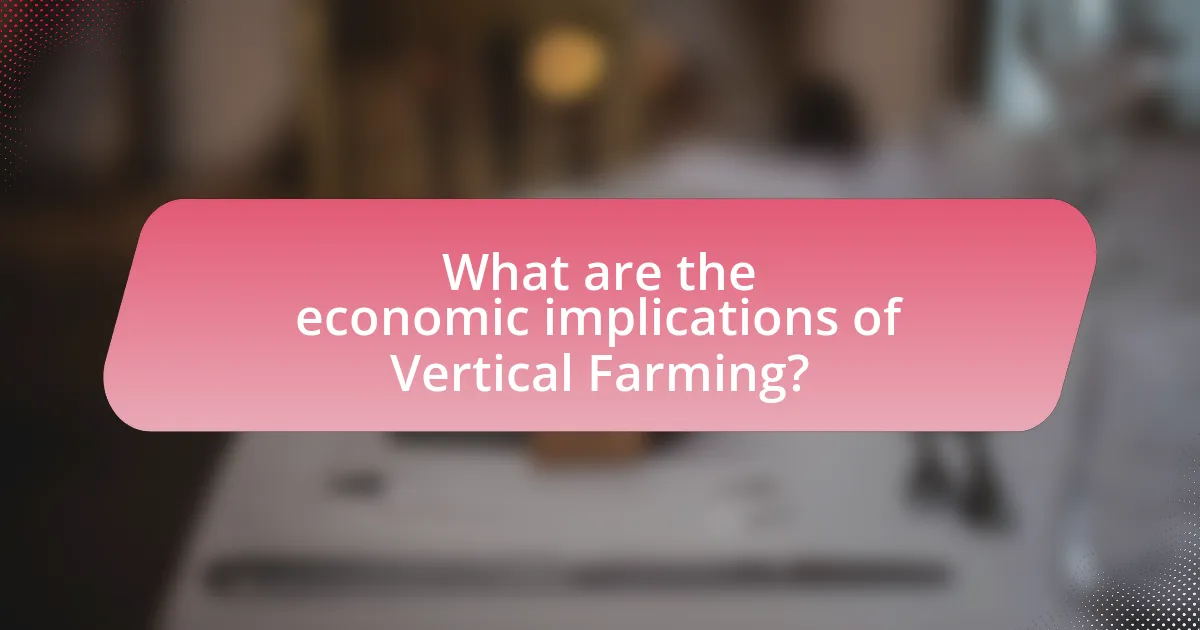
What are the economic implications of Vertical Farming?
Vertical farming has significant economic implications, primarily by reducing costs associated with traditional agriculture. It minimizes transportation expenses due to proximity to urban markets, which can lower food prices for consumers. Additionally, vertical farming utilizes less land and water, leading to lower resource costs; for instance, it can use up to 90% less water than conventional farming methods. The technology also allows for year-round crop production, increasing yield and profitability. According to a report by the Food and Agriculture Organization, urban agriculture, including vertical farming, can contribute to food security and economic resilience in cities, potentially generating billions in revenue.
How does Vertical Farming impact local economies?
Vertical farming positively impacts local economies by creating jobs, reducing food transportation costs, and increasing access to fresh produce. The establishment of vertical farms generates employment opportunities in urban areas, with studies indicating that these farms can create up to 10 times more jobs per acre compared to traditional agriculture. Additionally, vertical farming minimizes the distance food travels from production to consumption, which lowers transportation expenses and carbon emissions. This localized production model enhances food security and provides communities with fresh, nutritious options, contributing to overall economic resilience.
What job opportunities does Vertical Farming create?
Vertical farming creates diverse job opportunities across various sectors, including agriculture, technology, and logistics. Positions include farm managers, agronomists, and horticulturists who oversee plant growth and health, as well as engineers and technicians who maintain the advanced systems used in vertical farms. Additionally, roles in marketing, sales, and distribution are essential for bringing products to market. According to a report by the Association for Vertical Farming, the industry is expected to generate over 1 million jobs globally by 2030, reflecting its rapid growth and the increasing demand for sustainable food production methods.
How can Vertical Farming reduce food transportation costs?
Vertical farming can significantly reduce food transportation costs by enabling food production closer to urban consumers. This proximity minimizes the distance food must travel from farm to table, thereby lowering fuel expenses and reducing the need for extensive logistics networks. For instance, a study by the National Academy of Sciences found that urban vertical farms can cut transportation costs by up to 50% compared to traditional farming methods, as they eliminate the need for long-haul trucking. Additionally, vertical farms can operate in urban areas where land is scarce, allowing for fresh produce to be grown and sold locally, further decreasing transportation expenses and spoilage rates associated with long-distance shipping.
What are the investment opportunities in Vertical Farming?
Investment opportunities in vertical farming include technology development, infrastructure investment, and operational efficiency improvements. The vertical farming market is projected to reach $12.77 billion by 2026, growing at a CAGR of 24.8% from 2021, indicating strong financial potential. Investors can focus on innovative growing systems, automation technologies, and sustainable practices that enhance yield and reduce resource consumption. Additionally, partnerships with local grocery chains and restaurants can create direct sales channels, further increasing profitability.
How can investors assess the viability of Vertical Farming projects?
Investors can assess the viability of Vertical Farming projects by analyzing key factors such as market demand, operational costs, technology efficiency, and regulatory environment. Market demand can be evaluated through trends in local food consumption and preferences for fresh produce, which have shown a growing inclination towards sustainable and locally sourced food options. Operational costs, including energy consumption and labor, must be scrutinized; for instance, studies indicate that energy-efficient LED lighting can reduce costs significantly, making projects more feasible. Technology efficiency is critical, as advancements in hydroponics and aeroponics can enhance yield and reduce resource usage, with some systems reporting up to 90% less water usage compared to traditional farming. Lastly, understanding the regulatory environment is essential, as local zoning laws and agricultural regulations can impact project implementation and sustainability.
What trends are driving investment in Vertical Farming technologies?
Investment in Vertical Farming technologies is primarily driven by the increasing demand for sustainable food production and urban agriculture solutions. This trend is fueled by the need to address food security challenges posed by population growth and urbanization, as well as the desire to reduce the environmental impact of traditional farming methods. According to a report by MarketsandMarkets, the vertical farming market is projected to grow from $3.1 billion in 2020 to $12.77 billion by 2026, reflecting a compound annual growth rate (CAGR) of 25.0%. Additionally, advancements in technology, such as LED lighting and hydroponics, are enhancing the efficiency and profitability of vertical farms, further attracting investment.
What best practices should be followed in Vertical Farming?
Best practices in vertical farming include optimizing space utilization, implementing efficient water management systems, and utilizing controlled environment agriculture (CEA) techniques. Optimizing space involves using vertical structures and modular designs to maximize crop yield per square foot. Efficient water management, such as hydroponics or aeroponics, reduces water usage by up to 90% compared to traditional farming methods. CEA techniques, including precise control of temperature, humidity, and light, enhance plant growth and reduce pest infestations. These practices collectively contribute to higher productivity and sustainability in urban agriculture.
How can Vertical Farmers ensure crop quality and yield?
Vertical farmers can ensure crop quality and yield by implementing precise environmental controls, utilizing advanced hydroponic or aeroponic systems, and employing data-driven monitoring techniques. These methods allow for optimal growth conditions, such as regulated light, temperature, humidity, and nutrient delivery, which are critical for maximizing plant health and productivity. Research indicates that controlled environment agriculture can increase crop yields by up to 10 times compared to traditional farming methods, as reported in the study “Vertical Farming: A Global Perspective” by Despommier (2013). This evidence supports the effectiveness of these practices in enhancing both quality and yield in vertical farming systems.
What are the common pitfalls to avoid in Vertical Farming?
Common pitfalls to avoid in vertical farming include inadequate planning, poor crop selection, and inefficient resource management. Inadequate planning can lead to insufficient space utilization and operational inefficiencies, which can hinder productivity. Poor crop selection may result in lower yields and increased susceptibility to pests and diseases, as certain crops may not thrive in vertical systems. Inefficient resource management, particularly regarding water and energy use, can escalate operational costs and negate the sustainability benefits of vertical farming. According to a study published in the journal “Agricultural Systems,” optimizing these factors is crucial for maximizing the economic viability and environmental sustainability of vertical farming operations.
